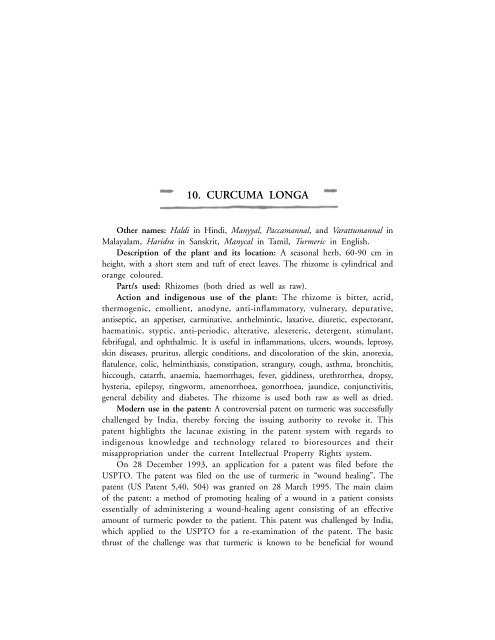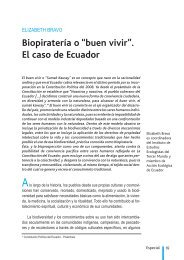BIOPIRACY Imitations Not Innovations - Biopirateria
BIOPIRACY Imitations Not Innovations - Biopirateria
BIOPIRACY Imitations Not Innovations - Biopirateria
You also want an ePaper? Increase the reach of your titles
YUMPU automatically turns print PDFs into web optimized ePapers that Google loves.
42 Biopiracy: <strong>Imitations</strong> <strong>Not</strong> <strong>Innovations</strong><br />
10. CURCUMA LONGA<br />
Other names: Haldi in Hindi, Manyyal, Paccamannal, and Varattumannal in<br />
Malayalam, Haridra in Sanskrit, Manycal in Tamil, Turmeric in English.<br />
Description of the plant and its location: A seasonal herb, 60-90 cm in<br />
height, with a short stem and tuft of erect leaves. The rhizome is cylindrical and<br />
orange coloured.<br />
Part/s used: Rhizomes (both dried as well as raw).<br />
Action and indigenous use of the plant: The rhizome is bitter, acrid,<br />
thermogenic, emollient, anodyne, anti-inflammatory, vulnerary, depurative,<br />
antiseptic, an appetiser, carminative, anthelmintic, laxative, diuretic, expectorant,<br />
haematinic, styptic, anti-periodic, alterative, alexeteric, detergent, stimulant,<br />
febrifugal, and ophthalmic. It is useful in inflammations, ulcers, wounds, leprosy,<br />
skin diseases, pruritus, allergic conditions, and discoloration of the skin, anorexia,<br />
flatulence, colic, helminthiasis, constipation, strangury, cough, asthma, bronchitis,<br />
hiccough, catarrh, anaemia, haemorrhages, fever, giddiness, urethrorrhea, dropsy,<br />
hysteria, epilepsy, ringworm, amenorrhoea, gonorrhoea, jaundice, conjunctivitis,<br />
general debility and diabetes. The rhizome is used both raw as well as dried.<br />
Modern use in the patent: A controversial patent on turmeric was successfully<br />
challenged by India, thereby forcing the issuing authority to revoke it. This<br />
patent highlights the lacunae existing in the patent system with regards to<br />
indigenous knowledge and technology related to bioresources and their<br />
misappropriation under the current Intellectual Property Rights system.<br />
On 28 December 1993, an application for a patent was filed before the<br />
USPTO. The patent was filed on the use of turmeric in “wound healing”. The<br />
patent (US Patent 5,40, 504) was granted on 28 March 1995. The main claim<br />
of the patent: a method of promoting healing of a wound in a patient consists<br />
essentially of administering a wound-healing agent consisting of an effective<br />
amount of turmeric powder to the patient. This patent was challenged by India,<br />
which applied to the USPTO for a re-examination of the patent. The basic<br />
thrust of the challenge was that turmeric is known to be beneficial for wound



